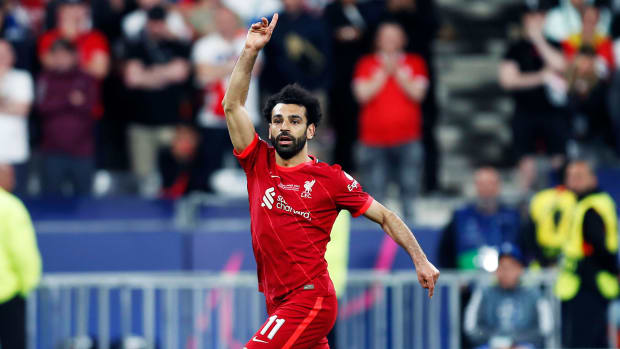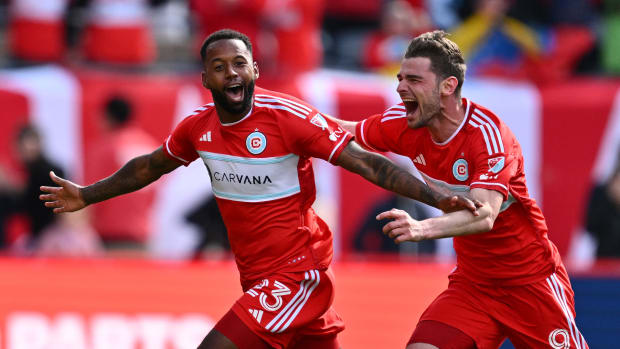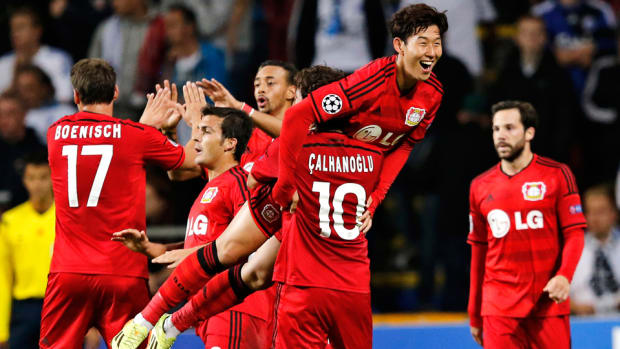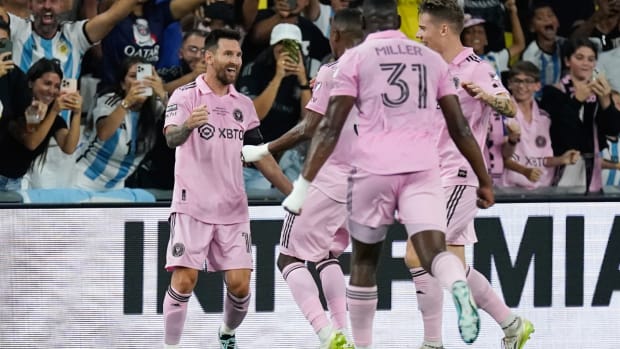Search for signs of a dynasty in potential peril, and it would be wise to look beyond wins, losses or even anything in this country. Instead, notice the 60,063 fans who filled London’s Emirates Stadium on May 1 or the 72,262 supporters who serenaded their beloved Barcelona following a match at Camp Nou a few days earlier. Listen for the sounds heralding a tectonic shift.
“Una bandera ens agermana,” the Barcelona fans sang, as they have for decades. “Blaugrana al vent, un crit valent. Tenim un nom, el sap tothom.” Roughly translated from Catalan, it means, “One flag unites us. Blue and claret on the wind, one valiant cry. We have a name that everyone knows.”
Barça tied Chelsea that night and eked out its two-game Champions League semifinal series by a single goal on aggregate. At the Emirates, Arsenal was eliminated by visiting Wolfsburg in extra time. These are names everyone knows, and both matches had the look and feel of those iconic European nights. But what made them relevant, and perhaps even threatening to the dynasty across the Atlantic, is that those matches were played by women. The U.S. women’s national team is, without question, the most dominant women’s soccer team in the world. But today, its seat on the summit could be challenged by countries that are home to the sport’s traditional powers and are gaining ground by finally investing in women.
The American women have lost just four World Cup games ever. They have won the sport’s premier competition four times (and medaled in the remaining four), have been ranked No. 1 by FIFA since summer 2017 and have never fallen below second. They are the two-time defending champs and won each of their seven matches in France in ’19 in 90 minutes—something that had been accomplished by only the ’02 Brazilian men’s side featuring Ronaldo Nazário and Ronaldinho.
The U.S. stumbled at both the Rio and Tokyo Olympics, but that’s a smaller tournament of reduced prestige that the team had already won four times. In the main, the American women are soccer’s greatest dynasty, a relentless victory machine and cultural juggernaut that has become a living symbol of sustained athletic supremacy, along with female strength and potential. Theirs are the faces of the game, from Michelle Akers and Mia Hamm to Megan Rapinoe and Sophia Smith. They are New Zealand’s All Blacks. They are Bill Russell’s Celtics or Babe Ruth’s Yankees. For decades, the USWNT’s excellence has set the standard and defined the sport.
But the team will head to the ninth Women’s World Cup knowing that the gap is closing, aware of that tectonic shift. Rival national teams can’t recruit better players from other countries, but they can develop their own, and the big ones—the places where football is a way of life—are finally doing just that.
The U.S. women are still the world champions and the favorites Down Under. But an 11-6-3 record against the nations currently ranked Nos. 2 to 5 (Germany, Sweden, England and France) since 2017 suggests increasing parity. Any given day now happens a bit more frequently. Longtime soccer insiders would recognize the reason. Last year in the voting for world soccer’s two premier individual honors, FIFA’s The Best award and France Football’s Ballon d’Or, only two Americans appeared in either top 10 (Alex Morgan placed second in FIFA’s balloting, and 23-year-old midfielder Catarina Macario was ninth in the Ballon d’Or).
“By far, we are in a different landscape in women’s soccer than there’s ever been,” says retired USWNT midfielder Aly Wagner, now a broadcaster. “We’re at a place now that teams don’t fear the U.S. anymore. They play with us and against us in club football. They’ve beaten us and they’ve seen other teams beat us.”
Wagner is a two-time Olympic gold medalist but was part of the group that faltered at two World Cups in the 2000s. The U.S. lost just two of 23 games in ’03, but one was to an excellent German side in the World Cup semifinal. The only defeat during the entirety of ’05 to ’07 was against Brazil, in the ’07 World Cup semi that featured a first-half U.S. own goal and then a red card. There was talk then about the world catching up, but the reality was that the U.S. was a team in transition that fell short in a couple of knockout games. Since ’03, Germany, the only other team with multiple World Cup crowns, has won just one of 17 matches against the U.S. Since ’07, Brazil is 1-for-16 against the Americans.
“There were maybe four teams that could knock the U.S. out in the ’00s. . . . In those years we just had to have a bad day, and the other team had to have a good day,” says Wagner, who played on the team from 1999 to 2008. “But I felt like in ’15 there were real contenders that could’ve knocked us out. In ’19 I absolutely felt that way.”
The Americans won both tournaments, but for someone like Wagner, recent games have looked and felt different. She references the 2019 World Cup semifinal, in which England missed a late penalty kick that would’ve sent the game to extra time.
England’s Football Association suppressed the organization of women’s football for 50 years before finally permitting it in the early 1970s. The Lionesses, their national team, missed three of the first four World Cups. While Title IX was lighting the spark for women’s sports in the U.S., creating the developmental crucible that would power college soccer and USWNT dynasties, the English were struggling to recover from the dark ages.

The Euro 2022 champions England defeated the USWNT at a packed Wembley Stadium, 2–1, in October.
Karl W Newton/IMAGO
Considering that history, England’s recent emergence in the women’s game is remarkable. The Lionesses are the reigning European champions. They defeated the U.S. last fall and they’ll enter this year’s World Cup ranked fourth by FIFA. They’ve sold out Wembley Stadium multiple times. The renowned northwest London venue was filled with a record 77,390 for last month’s Women’s FA Cup final between Chelsea and Manchester United. The sport is surging. Domination may decrease, but greater competition is driving greater interest, mirroring a pattern we often see as sports grow in popularity.
- Women’s World Cup Schedule: Group list, streaming information.
The U.S. women are justifiably venerated for patiently constructing the foundation for their game and persevering through the decades. But their place at the top is now under threat by countries that possessed their own foundations all along. They just had to remove their blinders and recognize the potential surrounding them.
“We have been inspired by what has happened in the U.S. For me, they are role models—the best example in the world for understanding the potential of women athletes,” says Pedro Malabia, who heads development and strategic planning for Liga F, Spain’s 16-team women’s league. “But the States cannot compete in terms of brands in football: the tradition, the fan bases. Here, football is a religion.”
The Spanish women finally qualified for the World Cup in 2015, the same year Malabia left his hometown club, Valencia, to become La Liga’s head of women’s football. The club game was “absolutely dead” at that point, he recalls. But competing countries were starting to take women’s leagues more seriously, and the game’s traditional powers exist in a cutthroat world where no ground is ceded willingly. La Liga, the men’s circuit, stepped in to help teams get organized. By ’21, Liga F was fully professional.
“It was like a race. It was the fear of missing out,” Malabia says. “You can’t survive in this society not paying attention to women. It’s a reality. As a brand, you can’t resist this pressure.”
The average Liga F player earns around €30,000 to €40,000 (about $32,500 to $43,400) per year, says Malabia. That figure is below the $54,000 average established last year in a new CBA between the NWSL and its players. Most European leagues are also relatively top heavy; the NWSL is more competitive top to bottom.
But what Liga F, England’s WSL, France’s Division 1 Féminine and Germany’s Frauen-Bundesliga can offer right now is the visibility, prestige and pressure that come with competing for the most famous teams in the sport. Players are bolstered by an infrastructure that underpins the best men’s professional and national sides in the world, and they play before fans who’ve been vested in their club’s identity and success for generations. Those Champions League nights beckon. That’s a platform for talent development that should cause concern for every American interested in maintaining their vaunted position.
Among the 14 nominees for last year’s The Best FIFA Women’s Player award, just two—Morgan and Brazil’s Debinha—play in the NWSL.
“Now it’s time for the U.S. stakeholders in the sports industry to maybe evolve their strategy or to take new steps,” Malabia says.
The gap has closed, and Wagner is among those stepping up. She has partnered with Hall of Famer Brandi Chastain and former U.S. teammates Danielle Slaton and Leslie Osborne to launch a San Francisco Bay Area team that’ll become the 14th NWSL club next year. Wagner is already thinking about improving player development—what worked in the U.S. for years may not be ideal going forward.
“The density of women’s players, and the quality of the players coming out of those [European] markets, is matching or surpassing ours,” Wagner says. “But there’s something to the fact that all boats rise together. Finally, the rest of the world is starting to recognize the value of women’s football. It’s all positive. I think we drive forward together. The proof in our model is there. Now the proof in their model is there.”
So let the competition begin.







